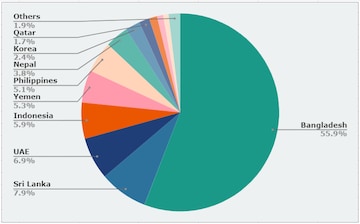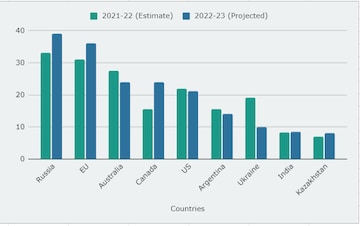Wheat prices hit a record high on Monday after India announced its decision to ban exports of the commodity last week with immediate effect and indefinitely.
The price, already high due to Russia's invasion of Ukraine which is a major exporter of wheat, touched 435 euros ($453) per tonne as the European market opened.
India’s decision to ban wheat export will have significant global implications with several low income developing countries — mainly those from Asia and Middle-East — set to be impacted.
“The impact will be felt disproportionately by low income developing countries, although India’s government has left open the option to export to vulnerable countries,” said a Nomura report.
Bangladesh would be among the most hit country as it accounts for 55.9 percent of India’s total wheat exports, followed by Sri Lanka (7.9 percent), UAE (6.9 percent), Indonesia (5.9 percent), Yemen (5.3 percent) and Philippines (5.1 percent), according to the report by Nomura.
Among the other countries that would see the impact are Nepal, Korea, Qatar, Oman and Malaysia.
India's wheat exports by destination from March 2021 to February 2022 (in%):

Source: Commerce Ministry and Nomura Global Economics
“In Asia, except for Australia and India, most other economies depend on imported wheat for domestic consumption and are at risk from higher wheat prices globally, even if they do not directly import from India,” said the report.
“We see rising food inflation as an upside risk to the overall inflation outlook in Asia. Food has a larger weighting in the consumer expenditure baskets of emerging Asia,” it added.
On Saturday, India banned wheat exports with immediate effect as part of the government’s efforts to control rising domestic prices and as heatwave across the country affects the domestic output. "The export policy of wheat is prohibited with immediate effect," the Directorate General of Foreign Trade (DGFT) said.
The DGFT clarified that wheat exports will be allowed only if the government grants permission to meet the food security needs of other countries based on the request of their governments.
India’s ban on wheat export would lead to significant pressure on global wheat prices which have been already rising owing to higher energy costs and the Russia-Ukraine war.
As per the estimates of the United States Department of Agriculture (USDA), as cited by Nomura, India is the world’s eighth largest wheat exporter and accounted for 4.1 percent of total global wheat exports in 2020-21. The country produced 109.6 metric tonne (mt) of wheat in 2021-22, of which 8.2mt was exported, up from 2.6mt of exports in 2020-21.
With India’s wheat export ban, the USDA’s 2022-23 export projections — already hit by the war in Ukraine — are likely to be revised lower.
Top wheat exporters globally (in million metric tons):

Source: USDA WASDE (May 2022) and Nomura Global Economics
However, the impact of the wheat export ban on India’s domestic food inflation is likely to be muted, according to the Nomura report.
“This export ban is a pre-emptive step and may prevent local wheat prices from rising substantially; however, with domestic wheat production likely limited by the heatwave, local wheat prices may not moderate materially. If India’s wheat ban leads to higher price of substitutes like rice, then there could be upward pressure on other food prices,” said the report.
First Published: May 16, 2022 12:26 PM IST

 Source: Commerce Ministry and Nomura Global Economics
Source: Commerce Ministry and Nomura Global Economics Source: USDA WASDE (May 2022) and Nomura Global Economics
Source: USDA WASDE (May 2022) and Nomura Global Economics
